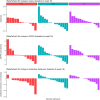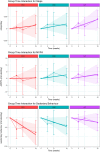TRACK & ACT: a pragmatic randomised controlled trial exploring the comparative effectiveness of pedometers and activity trackers for changing physical activity and sedentary behaviour in inactive individuals
- PMID: 40217539
- PMCID: PMC11960358
- DOI: 10.1186/s44167-023-00018-4
TRACK & ACT: a pragmatic randomised controlled trial exploring the comparative effectiveness of pedometers and activity trackers for changing physical activity and sedentary behaviour in inactive individuals
Abstract
Background: Pedometers have been shown to be effective for increasing physical activity, however the potential additional effects of activity trackers, and their added capacity to simultaneously modify sedentary behaviour, has not been thoroughly explored. This study aimed to explore the comparative effectiveness of two activity trackers and a pedometer for improving daily step count and moderate-vigorous physical activity (MVPA), and reducing sedentary behaviour in inactive adults.
Methods: 48 inactive participants were allocated to one of three groups based on their workplace. Each group randomly received either a Fitbit ONE, Jawbone UP or Digi-Walker SW200 pedometer (PED) for 8-weeks and an orientation session to their respective device. Participants were informed about the study aims and were provided with their respective devices and where applicable, the associated Apps. Participants intentionally received no other active intervention components to simulate as closely as possible the experience of purchasing a device 'off the shelf'. Step count, MVPA and time in sedentary behaviour were measured using accelerometry (Actigraph GT3X+) at baseline and four-, eight- and 16-weeks. Analyses were conducted using linear mixed-effect regression models to compare changes from baseline. Post-hoc tests of model estimates compared each activity tracker group to the pedometer group. Model estimates are reported for baseline-16 week follow-up.
Results: At baseline, average (standard deviation) step count, MVPA and time spent sedentary was 6557 (2111) steps/day, 23 (13) minutes/day and 10.3 (1.0) hours/day in the PED group, 7156 (1496) steps/day, 26 (12) minutes/day and 9.3 (1.2) hours/day in the ONE group and 6853 (1281) steps/day, 29 (10) minutes/day and 10.1 (1.0) hours/day in the UP group. At 16-weeks, based on estimates from the linear mixed-effect regression model, the ONE and UP groups increased step count by 129 steps/day (95% CI - 1497, 1754) and 504 steps/day more (95% CI - 1120, 2130), respectively, than the PED group. For MVPA, the ONE and UP groups increased by 2.3 min/day (95% CI - 10.9, 15.4) and 2.7 min/day more (95% CI - 10.5, 15.8), respectively, than the PED group. For sedentary behaviour, the ONE group had 34 min/day more in time spent sedentary than the PED group (95% CI - 35, 104), while the UP group had 53 min/day more in time spent sedentary than the PED group (95% CI - 18, 123).
Conclusions: All three groups demonstrated an increase in steps and MVPA, and a decrease in time spent in sedentary behaviour, however there was substantial individual variation in these outcomes indicating considerable uncertainty about the relative effectiveness of activity trackers and pedometers in improving PA and sedentary behaviour. Randomised controlled trials with adequate sample sizes are indicated.
Trial registration: ACTRN12623000027617 (retrospectively registered 11/1/2023).
Keywords: Activity trackers; Adults; Health-related behavior; Intervention; Pedometer; Physical activity; Sedentary behavior.
© 2023. The Author(s).
Conflict of interest statement
Declarations. Ethics approval and consent to participate: The study was approved by The University of Queensland Ethics Committee (2014000766) and was conducted in adherence with the National Statement on Ethical Conduct in Human Research. All participants provided written informed consent to participate. Consent for publication: Not applicable. Competing interests: The authors declare that they have no competing interests.
Figures




Similar articles
-
Estimating Physical Activity and Sedentary Behavior in a Free-Living Context: A Pragmatic Comparison of Consumer-Based Activity Trackers and ActiGraph Accelerometry.J Med Internet Res. 2016 Sep 7;18(9):e239. doi: 10.2196/jmir.5531. J Med Internet Res. 2016. PMID: 27604226 Free PMC article. Clinical Trial.
-
Comparison of Students' Physical Activity at Different Times and Establishment of a Regression Model for Smart Fitness Trackers.Sensors (Basel). 2025 Mar 11;25(6):1726. doi: 10.3390/s25061726. Sensors (Basel). 2025. PMID: 40292814 Free PMC article.
-
Workplace pedometer interventions for increasing physical activity.Cochrane Database Syst Rev. 2020 Jul 21;7(7):CD009209. doi: 10.1002/14651858.CD009209.pub3. Cochrane Database Syst Rev. 2020. PMID: 32700325 Free PMC article.
-
Effect of a Primary Care Walking Intervention with and without Nurse Support on Physical Activity Levels in 45- to 75-Year-Olds: The Pedometer And Consultation Evaluation (PACE-UP) Cluster Randomised Clinical Trial.PLoS Med. 2017 Jan 3;14(1):e1002210. doi: 10.1371/journal.pmed.1002210. eCollection 2017 Jan. PLoS Med. 2017. PMID: 28045890 Free PMC article. Clinical Trial.
-
Interventions outside the workplace for reducing sedentary behaviour in adults under 60 years of age.Cochrane Database Syst Rev. 2020 Jul 17;7(7):CD012554. doi: 10.1002/14651858.CD012554.pub2. Cochrane Database Syst Rev. 2020. PMID: 32678471 Free PMC article.
References
-
- Katzmarzyk PT, Friedenreich C, Shiroma EJ, Lee IM. Physical inactivity and non-communicable disease burden in low-income, middle-income and high-income countries.Br J Sports Med. 2021:bjsports-2020-103640. - PMC - PubMed
-
- Ding D, Lawson KD, Kolbe-Alexander TL, Finkelstein EA, Katzmarzyk PT, van Mechelen W, et al. The economic burden of physical inactivity: a global analysis of major non-communicable diseases. The Lancet. 2016;388(10051):1311–24. - PubMed
LinkOut - more resources
Full Text Sources
